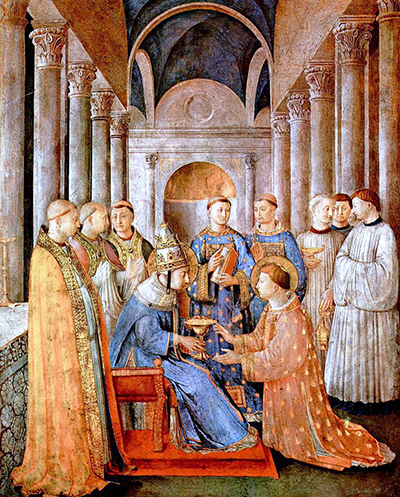Saint Lawrence is an important figure within Christianity and artist Fra Angelico chose to feature scenes from his life within the chapel of Saint Nicholas V which is based in Vatican City, Italy. He would also address the life of Saint Stephen as well with some accompanying artworks.
This detailed piece features both figurative and architectural work in a well crafted fresco. We find the saint being ordaned in the foreground, with a group of figures there to witness events in person. Behind them is then a series of solid stone structures which lead up to a decorative wall at the very back of the composition. Fra Angelico attempts to produce a feeling of perspective through the angles of the two side walls, and his own method of producing perspective still beared some similarities with aspects of art from the Middle Ages. This technique was still in development during the early stages of the Renaissance, and many later artists would take the work of Fra Angelico and push his ideas onwards once more. One can compare this a century or two prior, where most artworks were relatively flat in approach, underlining how things were just starting to change within Italy during the 15th century. Aside from that, the stunning attire of the figures in this scene is also a point of interest.
This painting is also sometimes known as St. Peter Consecrates St. Laurence as Deacon and measures 271 cm in height by 197 cm in width. Fra Angelico completed his series of frescoes within the chapel between the years of 1447–1449, though some of his designs would actually be completed many years after his death by Luca Signorelli. It is also believed that some of the work attributed directly to Fra Angelico's hand would also have involved his assistants as well, as he worked in a collaborative way throughout the latter part of his career. By the time of this fresco series, he had already reached the summit of his powers and was comfortable in tackling all manner of different religious content and themes. He would produce hundreds of artworks across his career, with his work within the Niccoline Chapel considered by some to be amongst his best, alongside the likes of Annunciation, The Last Judgement and San Marco Altarpiece.
Fra Angelico would work on religious themes throughout his career as these were requested by his patrons. Most were connected to the Church and this is also where most of the wealth resided in Italy at that time. There would then later be some prominent families who were independantly wealthy that in later years offered alternative types of commissions but throughout the Early Renaissance most artists would work in a similar manner to that of Fra Angelico. Indeed, it was some of the developments that he made which inspired others who followed on afterwards, and there was much to learn during this era as things started to move on from the methods used across Europe during the Middle Ages.




